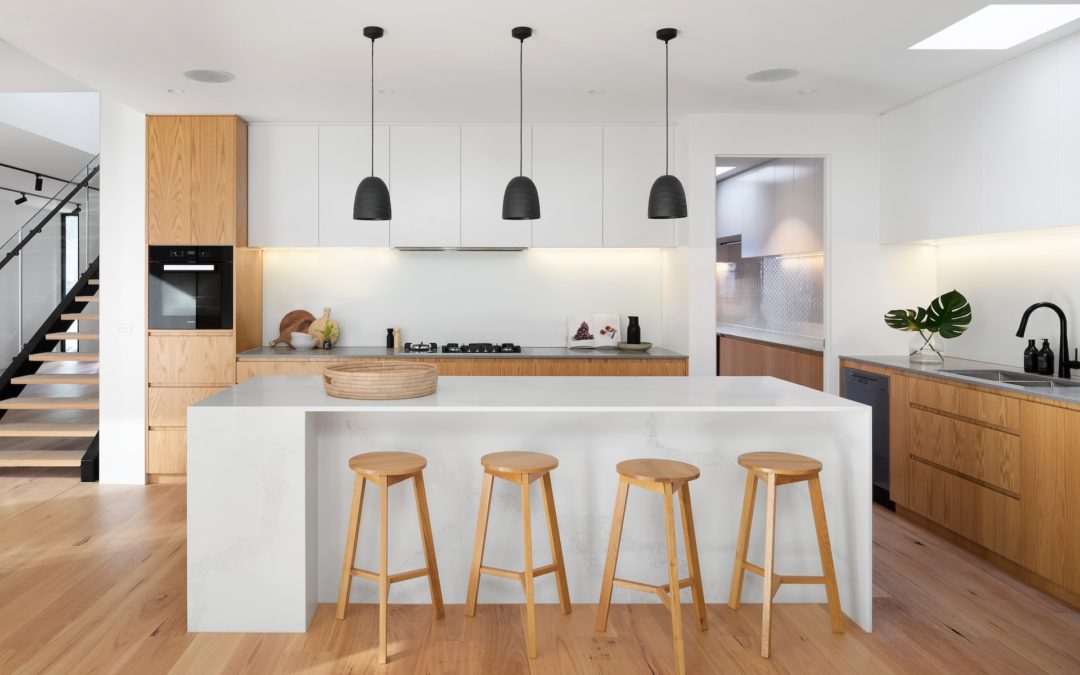If you’ve owned your home for a while, it may be time to remodel your kitchen. It’s the center of many homes, and a beautiful kitchen can significantly improve the look and value of a house. When remodeling a kitchen, one of the most important considerations is the flooring. Whether you choose linoleum, tile, or hardwood, a new surface will make your kitchen stand out.
If you’re planning on replacing the floors in your kitchen, you may be wondering whether it’s necessary to remove or replace the ground-level cabinets at the same time. Although removing these installations can lead to extra hassle, it’s important to consider several factors before leaving them in place. At Steiner Homes in Northwest Indiana, we want to help you and your neighbors to create beautiful living spaces, and in this article, we discuss whether it’s possible to replace your floors without removing cabinets.
Can You Replace Kitchen Flooring Without Removing Cabinets?

Image by R ARCHITECTURE licensed under Unsplash License
The most straightforward answer to this question is yes, but many factors affect the feasibility of such a project. Whether this method works for you depends on the type of flooring your kitchen has, as well as the overall design of your kitchen and cabinetry. If you want to install a linoleum or wood laminate floor, installing these surfaces without removing your cabinets is possible. This is because these materials are thin enough to prevent a noticeable difference in height once the installation is complete.
Tile and hardwood floors can also be installed without removing cabinets, but it can be much more difficult. These materials are thicker, which can lead to your cabinets being lower after installation. It may also cause access issues for the lower cabinets.
Things To Consider When Replacing Kitchen Floors
Here are some of the most important factors you should consider when deciding whether to remove your cabinets:
Materials and Height
As mentioned above, your choice of material will make a big difference in whether you need to remove the cabinets in your kitchen. If you’re using a thin material, it might be easier to leave the cabinets as they are and shape the new surface around them. This is fairly simple if you have the proper tools and can yield attractive results.
If you plan to use tile or another thicker material, it may be necessary to remove the cabinets before installation. If you don’t, you’ll raise the height of the floors while the cabinets stay where they are. This can cause issues with appearance, access, and sealing later.
Weight
Underneath your kitchen floor, there’s another structure called the subfloor. This must be strong enough to support the materials you use to finish the kitchen floor. If you’re planning to replace your floors with a lightweight linoleum or laminate surface, this shouldn’t be a problem, especially if the previous materials were heavier. However, if you’re planning to install heavy tiles, it may be necessary to get the subfloor inspected by a professional.
They can check the strength of your subfloor and tell you whether it’s capable of supporting the materials you want to use. If it is, you can proceed with your project as planned, removing the cabinets or not. If the subfloor needs replacing, you’ll have to remove all the cabinetry before installation can begin.
Expansion and Contraction
Heat or moisture can cause materials, such as certain laminates, to expand and contract, resulting in cracks in the floor over time. If you remove your cabinets and install a laminate floor underneath, it may cause damage to the cabinetry if it contracts or expands. In these cases, it’s often best to leave the cabinets and fit the flooring materials around them since future repairs will be much simpler.
Sealing
Kitchen floors are often subjected to lots of moisture and liquids. Because of this, it’s important that they’re well sealed, especially around the edges. If they aren’t, moisture can leak in, causing expansion, contraction, and rot. With this in mind, it’s important to make sure that you seal the floor around the edges of your kitchen cabinets. If you can do this without removing them, then it might save you some hassle. However, if this is difficult, it might be better to remove the cabinets and lay the floor down underneath them.
Why Leave the Cabinets In?
These are some of the benefits of not removing your cabinets during the flooring process:
- Involves less work for you or your contractors.
- Allows you to keep your cabinetry and floor plan the same.
- Saves time and money.
- Saves flooring materials.
- Gives a good finish when using laminate surfaces.
- Allows expansion and contraction without damage to cabinets.
Why Take the Cabinets Out?
These are some of the advantages of removing your cabinets:
- Allows you to create a clean appearance without quarter rounds.
- Allows you to change the entire layout of the kitchen if desired.
- Makes it easier to seal.
- Allows you to replace or strengthen the subfloor.
What Should You Do?
When it comes to this question, the answer depends on your plans and the type of floor you currently have. If you want to put in wood floors, it might be best to leave the cabinets in to accommodate their natural shift. On the other hand, if you need to strengthen your floor, it might be better to take them out. If you’re not sure, it’s helpful to speak with a qualified flooring professional.
That’s a quick overview of some of the factors you should consider when replacing your floors. As you can see, it’s possible to leave your cabinets in place, but there are many advantages to removing them before re-doing your floors. If you live in Indiana, let Steiner Homes help you with any of your home-building needs. We offer a wide range of custom options and have a team of experienced professionals dedicated to providing the best service possible.
If you have any questions about our services or prices, feel free to contact us at any time, and we’ll walk you through our process and portfolio. We’ll do our utmost to get you the house you want at a price you can afford. If you want to know more about us, you can also explore our Northwest Indiana subdivisions online, as well as our floor plans. Good luck in your home search, and we hope to hear from you soon.

